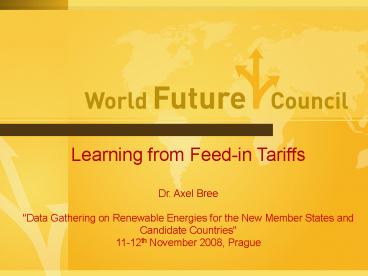PowerPointPrsentation - PowerPoint PPT Presentation
1 / 16
Title:
PowerPointPrsentation
Description:
'Data Gathering on Renewable Energies for the New Member States and ... Tariff Degression and Experience Curve. Tariffs are guaranteed for ... degression ... – PowerPoint PPT presentation
Number of Views:198
Avg rating:3.0/5.0
Title: PowerPointPrsentation
1
Learning from Feed-in Tariffs Dr. Axel
Bree "Data Gathering on Renewable Energies for
the New Member States and Candidate
Countries" 11-12th November 2008, Prague
2
Structure of Presentation
- Introduction
- Design of Feed-in Tariffs
- Tariff
- Purchase Obligation
- Burden Sharing
- Grid Connection
- Conclusion
3
The World Future Council
- The World Future Council
- consists of fifty highly respected figures
represented in governments, civil society,
business, science, education and the arts
from all five continents - is an integrated global forum based on mutual
ethical values, highlighting our
responsibilities as citizens of the earth - strives to mobilise moral energy and political
will to protect the rights of future
generations
3
4
Check out www.onlinepact.org and
www.AllianceforRenewableEnergy.org
5
Performance, Targets and Potential of Selected
Eastern European Countries
Share of RE in total electricity generation
6
Market Barriers
- distortion from subsidies for competing fuels
(NEF Report 2004 US 235 bn/a) - fluctuation of oil and gas prices
- environmental externalities
- planning restrictions
- grid access
- new technologies
RE support schemes are imperative
Source BEE, Lackmann, 2005
6
7
Pieces of the FIT Puzzle
Purchase Obligation
Tariff level
Burden sharing
Grid Connection
8
Calculation of Feed-in Tariff
- Generation Costs
- investment cost operating cost
- ./. expected production over service life
- compensation per kWh
- lt-gt avoided external costs
9
Design of Tariff Levels Stepped Tariffs
- All FIT tariffs differentiate between different
technologies (high PV low hydro) - Other differentiation criteria Location, wind
yield, plant size, fuel type, repowering - Ratio - no overcompensation
- stronger support for young technologies with
potential - Balance of incentives to exploit all, but most
favourable conditions first
10
Tariff Degression and Experience Curve
- Tariffs are guaranteed for long time periods
- Experience curve price for power plants and
installation decrease - Ways to reflect decrease in compensation scheme
- Tariff degression (D,F, I)
- Tariff level falls each year based on ex-ante
progress ratios for technology - investment security, transparency, incentive to
built early - Not flexible in case of structural changes
- Tariff revision (N, PT, CZ)
- Tariff is revised periodically (1-3 y.) or
capacity-related within certain limits - can apply to new or and old plants
- avoid over- or under compensation
- - Less investment security
11
Premium Tariff vs. Fixed Tariff
- Premium on top of market price (ESP, CZ, SI, NL,
DK) - Higher oil gas prices lead to higher cost per
kWh RES-E - higher comparability with liberalised energy
markets - Higher risk for producer (no purchase
obligation) - gtCompromise could be a top or bottom limit (as in
DK)
12
Purchase Obligation
- Electricity grid operators, energy supply
companies and consumers are obliged to buy RES
electricity
- Integral part of fixed FIT-system
- Guarantees investment security
- No purchase obligation with premium tariff system
13
Burden Sharing
- Compensation for energy intensive industries
- AU households pay lump charge of 15 /a,
industries up to 15.000 /a electricity traders
have to pay fixed tariff - DK reduction of 37-39 for consumption gt100
GWh/a - DE gt10 GWh energy costs gt15 gross value
added track railways tariff is limited to 0.05
ct./kWh
14
Costs of Grid Connection
15
Conclusion
Focus should be on long term planning and
investment security, because it is best incentive
to invest and keep costs low -gt long term fixed
tariff -gt priority purchase obligation -gt
reviews only in a restricted frame Regulation
must be well-balanced to give enough incentive
but to avoid windfall gains -gt stepped tariffs -gt
degressive tariffs -gt shallow connection charging
16
Thank you for your attention.
www.worldfuturecouncil.org































